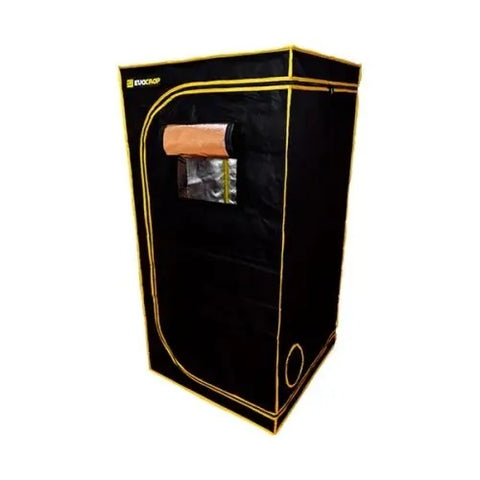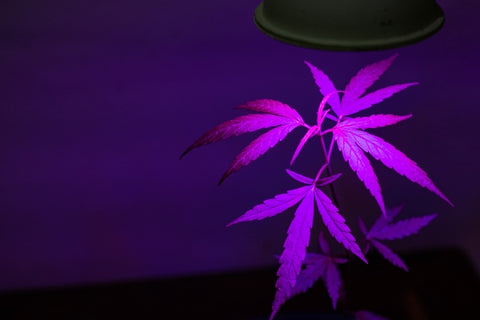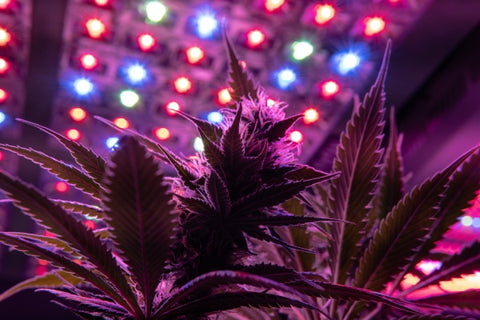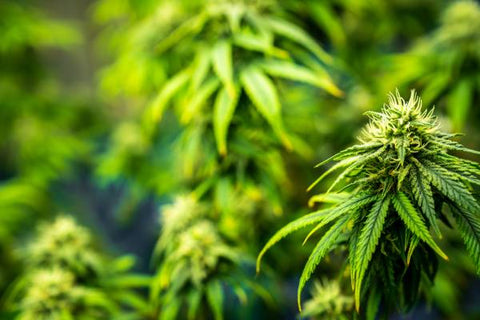Best price on the market

How to assemble an indoor wardrobe
At Grow Industry we launched this step-by-step guide through the process of setting up an efficient indoor closet for growing cannabis. You will understand why an indoor closet is a crucial investment for any serious grower and how this tool will allow you to create an optimal environment for the growth of your plants. From choosing the right space to setting up lighting and ventilation, we'll provide you with all the information you need so you can embark on this exciting journey with confidence.
Success in growing cannabis indoors is not just about choosing the right seeds and providing water and light. Planning and investing in a quality wardrobe are essential to achieving your goals. We will highlight the importance of planning, as it will allow you to optimize space, control the environment and, ultimately, maximize your harvest. Don't underestimate the value of a quality indoor wardrobe; It is the backbone of your growing operation and can make the difference between a mediocre harvest and an exceptional one.
Growing cannabis in a closet, a form of indoor cultivation , offers numerous advantages that make it attractive to many growers, especially those with limited space or the need for discretion. Here are the main advantages of this cultivation technique:
- Complete Environmental Control : Allows precise management of factors such as temperature, humidity, light and ventilation, optimizing growth conditions.
- Discretion and Security : Ideal for keeping cultivation private and safe, reducing exposure to external pests and diseases.
- Efficient Use of Space : Perfect for small spaces, allowing cultivation in areas where a larger crop would not be possible.
- Ease of Management : Simplifies plant care, including watering, pruning and pest control.
- Flexibility in Cultivation : It makes it possible to grow different strains and carry out cultivation cycles throughout the year, regardless of the seasons.
- Production Optimization : Improve yield and quality of buds by controlling conditions for each stage of the plant's life cycle.
- Reduction of External Risks : Less exposure to animals, theft or environmental pollution.
- Learning and Experimentation : Opportunity to learn and experiment with various techniques and cannabis strains.
- Energy Efficiency : Use of lighting technologies such as LED to reduce electricity costs.
- More Frequent Harvests : Possibility of accelerating cultivation cycles to obtain more regular harvests.
Closet cannabis cultivation stands out for its ability to create a controlled and personalized environment, making it a popular choice for both beginner and experienced growers.

Selection of Space and Wardrobe
Once you've decided to delve into the exciting world of indoor cannabis cultivation, the first step is to find the right space and select a grow room that perfectly fits your needs. This stage is essential for the success of your crop, since the controlled environment that your closet offers will be the determining factor in the quality and quantity of your harvest. Here we will guide you through the key aspects of this initial phase.
Choosing the right space
The first step is to carefully select the place where you will mount your indoor wardrobe. Here are some things to consider:
- Privacy and discretion : It is important that your space is protected from prying eyes. Discretion is essential, especially if you live in an area where cannabis legalization is limited or non-existent.
- Environmental control : Find a space that you can easily control in terms of temperature, humidity and light. Extreme fluctuations can negatively affect your plants.
- Access to electricity and water : Make sure you have easy access to sources of electricity and water. Indoor cultivation requires artificial lighting and regular irrigation.
- Ventilation : Plan adequate ventilation to maintain fresh air flow and avoid moisture and odor problems.
- Acoustic insulation : If discretion is crucial, consider acoustic insulation to minimize noise from equipment such as fans and extractors.
Types of cannabis growing cabinets
Once you have selected the space, it is time to choose the type of indoor growing tent that suits your needs. Indoor wardrobes come in different sizes and styles. Here are some common options:
- Fabric closets : They are lightweight and easy to assemble, but may not be as durable as other types.
- Rigid frame cabinets : Offer greater stability and durability, ideal for long-term crops.
- Complete grow tents : They include lighting, ventilation and filter systems, which simplifies setup, but are usually more expensive.
Cannabis grow tent size
The size of your indoor closet depends on your growing goals and the space available. Some common sizes include indoor wardrobe 100x100x200 cm and indoor wardrobe 240x120x200 cm. To determine the right size, consider the number of plants you want to grow and the type of light you plan to use. Remember that a larger cabinet will give you more room to maneuver and optimize your growing environment.
Lighting system
In the exciting journey of growing cannabis indoors, lighting is one of the key factors in ensuring your plants thrive. We'll explore the importance of proper lighting, compare the different types of lights available, and guide you through installation and programming so you can give your plants the light they need to grow healthily and vigorously.
Adequate lights
Lighting is essential for the growth of cannabis plants, as it plays a fundamental role in photosynthesis. During this process, plants convert light into energy, allowing them to grow and develop. Inadequate lighting can result in weak plants, low yields and low quality flowers. Here are some key considerations:
- Light spectrum : Cannabis plants require a combination of red and blue light for optimal growth . Red light is essential for flowering, while blue light is crucial in the vegetative growth stages.
- Light intensity : The light intensity must be sufficient to penetrate all parts of the plant, including the lower leaves. The distance between the lights and the plants is an important factor.
- Light duration : Establishing an appropriate light and dark cycle for each stage of growth is essential. Most growers use an 18-24 hour light cycle for vegetative growth and 12 hour light/12 hour dark cycle for flowering.
Types of lights
There are three main types of lights used in indoor cannabis cultivation, each with its advantages and disadvantages:
- LED : LED lights are gaining popularity due to their energy efficiency and ability to provide customized light spectrums for each stage of growth. They are durable and generate less heat, which can be beneficial for temperature control in your indoor closet.
- CFL (Compact Fluorescent Lamps) : These are inexpensive and suitable for beginner growers or those with limited budgets. However, their light spectrum is less efficient than other options, so they may result in lower performance.
- HPS (High Pressure Sodium) : HPS lamps are known for their ability to produce abundant crops and high-quality flowers. However, they generate more heat and consume more energy than LED lights.
The choice of light will depend on your budget, space and growing goals.
Installation and programming
Proper installation of lights is crucial to prevent injuries and ensure optimal performance. Follow these steps:
- Placement : Hang them safely inside the cabinet at the appropriate height to provide the required light intensity. Make sure they are equidistant from the plants.
- Programming : Set the light and dark cycle using electrical timers. Make sure you follow the proper cycle for each stage of growth.
- Ventilation : To avoid overheating, use extractors and fans to keep the cabinet temperature within an optimal range.

Ventilation and Climate Control
In the pursuit of successful indoor cannabis cultivation, ventilation and climate control are critical factors. You will learn why ventilation is essential, how to maintain an optimal environment in terms of temperature and humidity, and how to use fans and filters to ensure your plants thrive in a controlled, healthy environment.
Ventilation is a vital component of your indoor grow tent. Here are some reasons why it is essential:
- Airflow : A constant airflow prevents air stagnation and provides fresh carbon dioxide to your plants, which is essential for photosynthesis.
- Mold Prevention : Good ventilation helps reduce humidity in the air, which significantly decreases the risk of mold and disease in your plants.
- Odor Control : Proper ventilation also helps control odors, which is especially important if you want to keep your grow discreet.
Here are the key steps and considerations to effectively ventilate the interior of a grow tent:
- Installing Exhaust Fans : Place an exhaust fan at the top of the closet to expel hot, humid air, since hot air tends to rise. The capacity of the extractor should be appropriate for the size of your grow tent.
- Using Air Intractors : Install air extractors at the bottom of the closet to introduce fresh, colder air. This helps maintain constant air circulation and control temperature and humidity.
- Temperature and Humidity Control : Monitor and adjust the temperature and humidity inside the cabinet. Cannabis plants generally prefer temperatures between 20-30°C during the day and a little cooler at night. The ideal relative humidity varies depending on the growth stage, but is usually between 40-60%.
- Activated Carbon Filters : Consider installing an activated carbon filter in the extraction system to eliminate odors. This is especially useful if you need to keep your grow discreet.
- Circulation Fans : Place small fans inside the closet to move air around the plants. This helps strengthen plant stems and prevent hot, wet spots from forming.
- Regular Maintenance : Regularly clean and check extractors, intractors and fans to ensure they work efficiently and do not accumulate dust or debris.
- Adjustments According to Growth Stage: Adjust ventilation according to the needs of plants at different stages of their life cycle. For example, plants in the flowering stage may require more intense ventilation due to increased moisture and heat production.
- Automation and Sensors : Consider automating the ventilation system with timers and humidity and temperature sensors to maintain constant optimal conditions.
- Avoid Direct Drafts : Make sure fans do not blow air directly on plants to avoid stress or physical damage.
- Air Leak Inspection : Regularly check the cabinet for possible air leaks that could affect the controlled environment.
Proper ventilation in a grow tent not only regulates critical environmental factors such as temperature and humidity, but also reduces the risk of problems such as mold and pests, significantly contributing to the success of cannabis cultivation.

Containers and Substrate for Growing in a Cupboard
Choosing the appropriate containers for your cannabis plants, the substrate and the essential nutrients for their growth and we will provide you with instructions to carry out transplants and watering effectively in your indoor growing closet.
Choice of containers
Choosing the type of container is essential for the development of your plants. Here are some common options:
- Plastic pots : They are economical and widely used. They come in various sizes, but it is important to select one that fits the size of your plant.
- Fabric pots : They are breathable, which helps the roots get more oxygen. They are ideal to avoid excessive rooting problems.
- Autoflowering pots : These pots have a special shape that encourages radial root growth, which can be beneficial for some cannabis strains.
The choice of container depends on your preferences and the space available in your indoor closet.
Substrate and Fertilizers
The right substrate and proper nutrition are essential for successful cultivation. Here are some guidelines:
- Substrate : Choose a high-quality substrate designed specifically for growing cannabis. Often a mixture of soil and coconut works well. Make sure it has an adequate pH (6-6.8) and good water retention.
- Fertilizers : Research and select a balanced nutrient set that contains macronutrients (nitrogen, phosphorus, potassium) and micronutrients. Follow the manufacturer's instructions for adequate nutrition at each stage of growth.
Transplants and irrigation
Proper transplants and watering are essential to ensure your cannabis plants develop healthily:
- Transplants : As your plants grow, you may need to transplant them into larger containers to allow for optimal root growth. Do this carefully to avoid damaging the roots.
- Watering : Water your cannabis plants when the substrate is dry to the touch approximately 2-3 cm deep. Avoid overwatering, as it can cause root problems. Use pH-balanced water and be sure to drain excess water from the saucers.
Remember that each plant is unique, and it is important to observe them and adjust your growing practices according to their individual needs.

Care of Cannabis Plants at Different Stages
Caring for cannabis plants at different stages of their life cycle, we will learn about pruning and training techniques to improve the production and quality of buds, and we will discuss strategies for pest and disease control. Get ready to become an expert in caring for your indoor cannabis plants!
Cultivation phases
Cannabis cultivation goes through several key stages in its life cycle. Understanding these phases is essential to providing proper care:
- Germination : From the seed until the seedling emerges from the ground.
- Vegetative growth : During this phase, plants develop their structure and foliage.
- Flowering : It is the stage in which plants develop buds.
- Harvest : The time of harvest when the buds are ready to be picked.
Adjust the environment and nutrition of your plants according to the stage of growth they are in for the best results.
Pruning and training
There are several types of pruning for marijuana , find out to know which is best to increase the production and quality of the buds:
- Leaf pruning : Remove damaged or light-blocking leaves to improve air circulation and light penetration into the plant.
- LST (Low Stress Training) : Bend the main branches outward to create a more uniform canopy and promote more even bud growth.
- SCROG (Screen of Green) : Uses a mesh or net to guide branch growth and maintain a level and uniform canopy.
- Topping and FIMing : Cut the tip of the plant to encourage the growth of multiple colas of buds instead of a single main cola.
The choice of technique will depend on your objectives and experience as a grower.
Control ofpests and diseases in marijuana
Indoor cultivation is not free of problems such as pests and diseases. Here are some tips to prevent and treat common problems:
- Hygiene : Keep your closet and equipment clean and disinfected to avoid the proliferation of pests and diseases.
- Preventive control : Inspect your plants regularly for signs of pests or diseases at an early stage.
- Natural products : Use organic solutions such as neem oil or insecticidal soap to safely treat pests.
- Isolation : If you have had previous problems, consider isolating new plants to prevent the spread of pests or diseases.

Harvest and Drying
At this point, you have invested time and effort into your indoor cannabis cultivation and it is time to reap the fruits of your labor. Proper timing to harvest, the drying and curing process of your buds, and how to store them long-term to maintain their freshness.
Harvest time
Determining the exact time of harvest is crucial to obtain high-quality buds. Some indicators to know when the time is right include:
- Trichomes : Examine the trichomes on the buds with a magnifying glass or microscope. Look for milky or amber colored trichomes. Milky trichomes indicate high THC content, while amber trichomes suggest peak ripeness.
- Pistils : Observe the pistils (white hairs) on the buds. When at least 70-80% of the pistils have turned from white to amber or brown, it is an indication that it is time to harvest.
- Bud inflation : Buds will reach their maximum size before harvest. Wait until they have stopped growing to harvest.
Drying and curing
Once you have harvested your plants, it is essential to properly dry and cure the buds to preserve their quality. Follow these steps:
- Drying : Hang them upside down in a dark, cool, well-ventilated space for 7-10 days. The drying process reduces moisture in the buds and improves their flavor and aroma.
- Curing : After drying, place the buds in airtight glass jars. Open the jars daily for the first two weeks to release trapped moisture. Then reduce the opening frequency to every few days for several more weeks.
Curing improves the smoothness of the smoke, the potency and the aroma of your buds, creating an exceptional final product.
Long term storage
Once you've dried and cured your buds, it's important to store them properly to maintain their freshness for months:
- Airtight glass jars : Keep your buds in dark, airtight glass jars. This protects your cannabis from light, air and humidity, the main factors that can degrade its quality.
- Dark, cool storage : Store the jars in a dark, cool place, away from direct sunlight and sudden changes in temperature.
- Humidity Control : Use humidity control bags if necessary, to maintain an adequate humidity level in the jar.

Additional Tips for Growing Cannabis in a Closet
To successfully grow cannabis in a closet, in addition to the standard tips, there are some less common but equally effective practices that can make a significant difference in the health and performance of your plants. Here are some of these lesser-known tips:
- Using Green Light for Night Work : Cannabis plants generally do not respond to green light, which means you can use a green light to work in your closet during the dark period without disturbing the plants' light cycle.
- Application of Compost Tea or Worm Tea : These organic teas can be an excellent source of beneficial microorganisms and nutrients. Applying them can improve soil health and plant resistance to disease and stress.
- Use of Supplemental CO2 : Increasing CO2 levels in the closet can accelerate growth and increase performance. However, this must be done carefully and only in a completely closed system.
- Implementation of Controlled Stress Techniques : Techniques such as temperature stress (small controlled fluctuations) or mild water stress before flowering can increase trichome production.
- Using Adjustable Light Reflectors : Using adjustable reflectors allows you to change light distribution as plants grow, maximizing lighting efficiency and promoting uniform growth.
- Monitoring Drain Electrical Conductivity (EC) : Measuring the EC of drain water can provide valuable information about the amount of nutrients plants are absorbing, allowing you to adjust feeding as needed.
- Experimentation with Variable Light Spectra : Playing with different light spectrums during various phases of the life cycle can influence specific plant characteristics, such as flavor, aroma or potency.
- Using Essential Oils for Pest Control : Essential oils, such as neem oil, can be a natural and lesser-known alternative for pest control in an indoor growing environment.
- Applying Late Apical Pruning Techniques : Performing topping later than usual can result in a more open plant structure, which improves light penetration and air circulation.
- Use of Mycorrhizae and Beneficial Bacteria : Incorporating mycorrhizal fungi and beneficial bacteria into the substrate can significantly improve nutrient absorption and overall root health.
These less common tips can offer additional advantages to growing cannabis in a closet, helping to maximize plant health, bud quality, and overall harvest yield. However, it is important to remember that each technique must be applied with knowledge and caution to avoid adverse effects on plants.